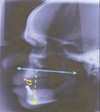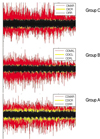1. van Waas MA. The influence of psychologic factors on patient satisfaction with complete dentures. J Prosthet Dent. 1990. 63:545–548.
2. Boerrigter EM, Geertman ME, Van Oort RP, Bouma J, Raghoebar GM, van Waas MA, van't Hof MA, Boering G, Kalk W. Patient satisfaction with implant-retained mandibular overdentures. A comparison with new complete dentures not retained by implants-a multicentre randomized clinical trial. Br J Oral Maxillofac Surg. 1995. 33:282–288.
3. Fenn HRB, Liddlelow KP, Gimson AP, MacCregor AR. Clinical Dental prosthetics. 1989. 3rd ed. Butterworth-Heinemann Ltd;290–304.
4. Winkler S. Essentials of complete denture prosthodontics. 1994. 2nd ed. Philadelphia: Ishiyaku Euro America;361–374.
5. Basker RM, Davenport JC, Tomlin HR. Prosthetic treatment of the edentulous patient. 2002. 4th ed. Blackwell Co;32–53.
6. Zarb GA, Bolender CL, Eckert SE. Prosthodontic treatment for edentulous patients: complete dentures and implant-supported prostheses. 2004. 12th ed. St. Louis: Mosby;123–159.
7. Mericske-Stern R, Steinlin Schaffner T, Marti P, Geering AH. Peri-implant mucosal aspects of ITI implants supporting overdentures. A five-year longitudinal study. Clin Oral Implants Res. 1994. 5:9–18.
8. Morais JA, Heydecke G, Pawliuk J, Lund JP, Feine JS. The effects of mandibular two-implant overdentures on nutrition in elderly edentulous individuals. J Dent Res. 2003. 82:53–58.
9. Budtz-Jørgensen E. Effect of controlled oral hygiene in overdenture wearers: a 3-year study. Int J Prosthodont. 1991. 4:226–231.
10. Visser A, Raghoebar GM, Meijer HJ, Batenburg RH, Vissink A. Mandibular overdentures supported by two or four endosseous implants. A 5-year prospective study. Clin Oral Implants Res. 2005. 16:19–25.
11. Passamonti G, Kotrajarus P, Gheewalla RK, Clark RE, Maness WL. The effect of immediate dentures on maxillomandibular relations. J Prosthet Dent. 1981. 45:122–126.
12. Schwartz IS, Morrow RM. Overdentures. Principles and procedures. Dent Clin North Am. 1996. 40:169–194.
13. Palmer R, Palmer P, Howe L. Complications and maintenance. Br Dent J. 1999. 187:653–658.
14. el Charkawi H. Immediate implant in fresh extraction socket of resected mandibular first molar: a preliminary clinical report. Implant Dent. 2001. 10:272–279.
15. Lambadakis J, Karkazis HC. Changes in the mandibular rest position after removal of remaining teeth and insertion of complete dentures. J Prosthet Dent. 1992. 68:74–77.
16. Saifuddin M, Miyamoto K, Ueda HM, Shikata N, Tanne K. A quantitative electromyographic analysis of masticatory muscle activity in usual daily life. Oral Dis. 2001. 7:94–100.
17. Slagter AP, Bosman F, van der Glas HW, van der Bilt A. Human jaw-elevator muscle activity and food comminution in the dentate and edentulous state. Arch Oral Biol. 1993. 38:195–205.
18. van Kampen FM, van der Bilt A, Cune MS, Bosman F. The influence of various attachment types in mandibular implant-retained overdentures on maximum bite force and EMG. J Dent Res. 2002. 81:170–173.
19. Prombonas A, Vlissidis D, Molyvdas P. The effect of altering the vertical dimension of occlusion on biting force. J Prosthet Dent. 1994. 71:139–143.
20. Todd JE, Lader D. Adult Dental Health 1988: United, Kingdom. Social Survey Report SS1260. 1991. London: HMSO.
21. Van Waas MA, Jonkman RE, Kalk W, Van't Hof MA, Plooij J, Van Os JH. Differences two years after tooth extraction in mandibular bone reduction in patients treated with immediate overdentures or with immediate complete dentures. J Dent Res. 1993. 72:1001–1004.
22. Renner RP. The overdenture concept. Dent Clin North Am. 1990. 34:593–606.
23. Langer Y, Langer A. Root-retained overdentures: Part II-Managing trauma between edentulous ridges and opposing dentition. J Prosthet Dent. 1992. 67:77–81.
24. Nagasawa T, Okane H, Tsuru H. The role of the periodontal ligament in overdenture treatment. J Prosthet Dent. 1979. 42:12–16.
25. Jemt T, Stålblad PA. The effect of chewing movements on changing mandibular complete dentures to osseointegrated overdentures. J Prosthet Dent. 1986. 55:357–361.
26. Schmitt A, Zarb GA. The notion of implant-supported overdentures. J Prosthet Dent. 1998. 79:60–65.
27. Naert I, De Clercq M, Theuniers G, Schepers E. Overdentures supported by osseointegrated fixtures for the edentulous mandible: a 2.5-year report. Int J Oral Maxillofac Implants. 1988. 3:191–196.
28. Payne AG, Solomons YF. Mandibular implant-supported overdentures: a prospective evaluation of the burden of prosthodontic maintenance with 3 different attachment systems. Int J Prosthodont. 2000. 13:246–253.
29. Karkazis HC. EMG activity of the masseter muscle in implant supported overdenture wearers during chewing of hard and soft food. J Oral Rehabil. 2002. 29:986–991.
30. Hemmings KW, Schmitt A, Zarb GA. Complications and maintenance requirements for fixed prostheses and overdentures in the edentulous mandible: a 5-year report. Int J Oral Maxillofac Implants. 1994. 9:191–196.
31. Huys LW. Replacement therapy and the immediate post-extraction dental implant. Implant Dent. 2001. 10:93–102.
32. Castellon P, Yukna RA. Immediate dental implant placement in sockets augmented with HTR synthetic bone. Implant Dent. 2004. 13:42–48.
33. Payne AG, Solomons YF. The prosthodontic maintenance requirements of mandibular mucosa- and implant-supported overdentures: a review of the literature. Int J Prosthodont. 2000. 13:238–243.
34. Salama H, Salama M. The role of orthodontic extrusive remodeling in the enhancement of soft and hard tissue profiles prior to implant placement: a systematic approach to the management of extraction site defects. Int J Periodontics Restorative Dent. 1993. 13:312–333.
35. Gelb DA. Immediate implant surgery: three-year retrospective evaluation of 50 consecutive cases. Int J Oral Maxillofac Implants. 1993. 8:388–399.
36. Becker W, Dahlin C, Becker BE, Lekholm U, van Steenberghe D, Higuchi K, Kultje C. The use of e-PTFE barrier membranes for bone promotion around titanium implants placed into extraction sockets: a prospective multicenter study. Int J Oral Maxillofac Implants. 1994. 9:31–40.
37. Brosh T, Persovski Z, Binderman I. Mechanical properties of bone-implant interface: an in vitro comparison of the parameters at placement and at 3 months. Int J Oral Maxillofac Implants. 1995. 10:729–735.
38. Sahin S, Cehreli MC, Yalçin E. The influence of functional forces on the biomechanics of implant-supported prostheses-a review. J Dent. 2002. 30:271–282.
39. Brzoza D, Barrera N, Contasti G, Hernández A. Predicting vertical dimension with cephalograms, for edentulous patients. Gerodontology. 2005. 22:98–103.
40. Gervais RO, Fitzsimmons GW, Thomas NR. Masseter and temporalis electromyographic activity in asymptomatic, subclinical, and temporomandibular joint dysfunction patients. Cranio. 1989. 7:52–57.
41. Ferrario VF, Sforza C, D'Addona A, Miani A Jr. Reproducibility of electromyographic measures: a statistical analysis. J Oral Rehabil. 1991. 18:513–521.
42. Visser A, McCarroll RS, Naeije M. Masticatory muscle activity in different jaw relations during submaximal clenching efforts. J Dent Res. 1992. 71:372–379.
43. Carlson CR, Okeson JP, Falace DA, Nitz AJ, Curran SL, Anderson D. Comparison of psychologic and physiologic functioning between patients with masticatory muscle pain and matched controls. J Orofac Pain. 1993. 7:15–22.
44. Carlson N, Moline D, Huber L, Jacobson J. Comparison of muscle activity between conventional and neuromuscular splints. J Prosthet Dent. 1993. 70:39–43.
45. Gay T, Rendell J, Majoureau A, Maloney FT. Estimating human incisal bite forces from the electromyogram/bite-force function. Arch Oral Biol. 1994. 39:111–115.
46. Türp JC, Schindler HJ, Pritsch M, Rong Q. Antero-posterior activity changes in the superficial masseter muscle after exposure to experimental pain. Eur J Oral Sci. 2002. 110:83–91.
47. Tallgren A, Holden S, Lang BR, Ash MM Jr. Jaw muscle activity in complete denture wearers-a longitudinal electromyographic study. J Prosthet Dent. 1980. 44:123–132.
48. Daubechies I. Orthonormal bases of compactly supported wavelets. Comm Pure Appl Math. 1988. 41:909–996.
49. Laurell L. Occlusal forces and chewing ability in dentitions with cross-arch bridges. Swed Dent J Suppl. 1985. 26:160.
50. Clark GT, Carter MC, Beemsterboer PL. Analysis of electromyographic signals in human jaw closing muscles at various isometric force levels. Arch Oral Biol. 1988. 33:833–837.




 PDF
PDF ePub
ePub Citation
Citation Print
Print











 XML Download
XML Download